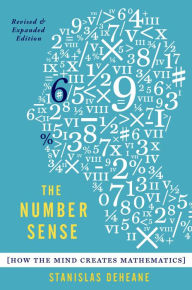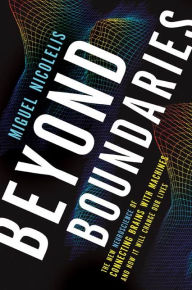Stanislas Dehaene was trained as a mathematician and psychologist before becoming one of the world’s most active researchers on the cognitive neuroscience of language and number processing in the human brain. He is the director of the Cognitive Neuroimaging Unit in Saclay, France, the professor of experimental cognitive psychology at the Collège de France, a member of the French Academy of Sciences and of the Pontifical Academy of Sciences. He has published extensively in peer-reviewed scientific journals and is the author of The Number Sense and Reading in the Brain. He lives in France.
Consciousness and the Brain: Deciphering How the Brain Codes Our Thoughts
eBook
-
ISBN-13:
9780698151406
- Publisher: Penguin Publishing Group
- Publication date: 01/30/2014
- Sold by: Penguin Group
- Format: eBook
- Pages: 352
- Sales rank: 126,001
- File size: 7 MB
- Age Range: 18 Years
What People are Saying About This
Available on NOOK devices and apps
Want a NOOK? Explore Now
WINNER OF THE 2014 BRAIN PRIZE
From the acclaimed author of Reading in the Brain, a breathtaking look at the new science that can track consciousness deep in the brain
How does our brain generate a conscious thought? And why does so much of our knowledge remain unconscious? Thanks to clever psychological and brain-imaging experiments, scientists are closer to cracking this mystery than ever before.
In this lively book, Stanislas Dehaene describes the pioneering work his lab and the labs of other cognitive neuroscientists worldwide have accomplished in defining, testing, and explaining the brain events behind a conscious state. We can now pin down the neurons that fire when a person reports becoming aware of a piece of information and understand the crucial role unconscious computations play in how we make decisions. The emerging theory enables a test of consciousness in animals, babies, and those with severe brain injuries.
A joyous exploration of the mind and its thrilling complexities, Consciousness and the Brain will excite anyone interested in cutting-edge science and technology and the vast philosophical, personal, and ethical implications of finally quantifying consciousness.
From the Trade Paperback edition.
Customers Who Bought This Item Also Bought
-
- Ha!: The Science of When We…
- by Scott Weems
-
- Looking for Spinoza: Joy,…
- by Antonio Damasio
-
- The Mind: Leading Scientists…
- by John Brockman
-
- Moral Tribes: Emotion, Reason,…
- by Joshua Greene
-
- The Number Sense: How the Mind…
- by Stanislas Dehaene
-
- A Skeptic's Guide to the…
- by Robert A. Burton
-
- Beyond Boundaries: The New…
- by Miguel Nicolelis
-
- The Mind and the Brain:…
- by Jeffrey M. SchwartzSharon Begley
-
- Who's in Charge?: Free…
- by Michael S. Gazzaniga
-
- Proust and the Squid: The…
- by Maryanne Wolf
-
- The Spiritual Brain: A…
- by Mario BeauregardDenyse O'Leary
-
- Incomplete Nature: How Mind…
- by Terrence W. Deacon
-
- Life at the Speed of Light:…
- by J. Craig Venter
-
- Euclid's Window: The Story…
- by Leonard Mlodinow
-
- The Agile Gene: How Nature…
- by Matt Ridley
-
- Me, Myself, and Why: Searching…
- by Jennifer Ouellette
Recently Viewed
Probing the links between conscious thought and the intricate networks and neurons that comprise our brains, cognitive psychologist Dehaene (Reading in the Brain) tackles questions of mind-body duality and the relationships between mental activity and the material world that have attracted and perplexed great scientific minds for centuries. Consciousness is only the tip of the neurological iceberg, in terms of the information our brains receive from sensory stimuli, and Dehaene’s innovative MRI research has identified a series of thresholds whereby information moves from a state of “preconscious” to “conscious” processing. With such emphasis on imaging and research examples, the discussion is more geared toward a scientifically minded population, though that is not to say that this is a completely esoteric read. Dehaene’s knack for explaining complex terms in interesting, understandable phrases is bolstered by accompanying images that enhance the basic comprehension of the material. And the study—which shows that consciousness can, despite its complexities, be in some ways identified and analyzed—has implications that extend beyond science, about people and animals alike. In all respects, this book will bring the brain’s marvelous mechanisms into clearer focus. (Feb.)
—The Washington Post
“Dehaene is a maestro of the unconscious.”
—Scientific American Mind
“Brilliant… Dehaene’s special contribution is his global-workspace theory, the first step in a complete account of why some neural processes lead to conscious experience…. Dehaene’s account is the most sophisticated story about the neural basis of consciousness so far. It is essential reading for those who want to experience the excitement of the search for the mind in the brain.”
—Chris Frith, Nature
“In Consciousness and the Brain, [Dehaene] summaries the fruits of two decades of vigorous experimentation and modeling…. The book introduces the methods that acted as midwife at the birth of a science of consciousness…. Postulating that global availability of information is what we subjectively experience as a conscious state begets the question of why…. Answering such questions requires an information-theoretical account of what type of data, communicated within what system, gives rise to conscious experience in biological or artificial organisms. Dehaene’s well-written and well-sourced book avoids this, as this, as he opts to restrict it to behavioral and neuronal observables.”
—Christof Koch, Science
“Consciousness tomes have become a dime a dozen over the past decade or so, with every last researcher feeling the need to join the fray. But Stanislas Dehaene is one of the few at the top of the disciplines involved – philosophy, history, cognitive psychology, brain imaging, computer modelling – to add something new.”
—New Scientist
“An excellent teacher with a gift for vivid analogies, Dehaene writes that ‘consciousness is like the spokesperson in a large institution . . . with a staff of a hundred billion neurons’ issuing briefs that tell us what we need to know moment by moment. He then explains his and his colleagues’ groundbreaking theory about the “global neuronal workspace,” where information is made ‘available to the rest of the brain,’ wowing us with descriptions of our pyramidal neurons and their spiny dendrites and the discovery that each neuron ‘cares’ about such specific stimuli as ‘faces, hands, objects.’ A stunning delineation of the “exquisite biological machinery” that has made us an animal unlike any other.”
—Booklist, starred review
“A revealing and definitely not dumbed-down overview of what we know about consciousness.”
—Kirkus Reviews
“Stanislas Dehaene’s remarkable book is the best modern treatment of consciousness I have read to date. Dehaene, a world-class scientist, has pioneered the development of a set of experiments for studying consciousness that have revolutionized the field and given us the first direct approach to its biology. Simply stated this book is a tour de force. It opens up a whole new world of intellectual exploration for the general reader.”
—Eric Kandel, author of In Search of Memory and The Age of Insight, and winner of the Nobel Prize in Physiology or Medicine
Dehaene (Experimental Cognitive Psychology/Collège de France; Reading in the Brain: The Science and Evolution of a Human Invention, 2009) delivers a detailed popular account of what he and fellow researchers have discovered about how perceptions become thoughts. Scientists once agreed with laymen that consciousness was a mystical phenomenon beyond the reach of experiments. Though many laymen still believe in that idea, scientists changed their minds more than 30 years ago. We pay attention to one thing at a time. Life would be impossible if the brain didn't suppress almost everything our senses detect. This makes "eyewitness" testimony unreliable, and the Internet teems with clips of experimental subjects blithely ignoring the obvious. LSD users describe deeply profound perceptions, but they are simply overwhelmed with information since the drug turns off the brain's suppressive function, making everything equally important. The unconscious is not merely a Freudian conjecture. Its operations are visible on brain imaging procedures and amenable to experiments. Furthermore, humans overestimate the power of consciousness. We routinely select a fraction of our unconscious pictures, amplify, name, memorize them, and use them to plan our actions. Consciousness research is turning up useful information. Catastrophic brain damage often reduces victims to vegetative or locked-in states during which they sleep and wake but remain unresponsive. New tests reveal a few whose brains (but not their bodies) respond to questions as if they were conscious. Barely conscious patients with relatively intact cerebral cortexes occasionally improve dramatically during electrical stimulation of the thalamus, a deep brain structure that regulates vigilance. "What is certain," writes the author, "is that, in the next decades, the renewed interest in coma and vegetative states…will lead to massive improvements in medical care." A revealing and definitely not dumbed-down overview of what we know about consciousness.
















